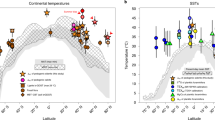Abstract
DECREASE in temperature with depth which was first observed by Sorge1 in the top 20 m. of ice at Eismitte in Greenland has since been confirmed for much deeper strata there2,3 and in Antarctica4,5. Sorge thought that the negative temperature gradient could have been created by a secular rise in air temperature. Independent evidence exists for such a trend in Greenland but not in Antarctica6. Moreover, the much greater depth to which a steady decrease in temperature in the ice has now been traced would require a surface warming extending over very long periods. In these circumstances it seems necessary to consider first the effects of the warming of the ice-cap surface connected with the decrease in its height during the outward movement of the ice. By geometrical reasoning Robin7 deduced that in the absence of heat conduction this movement (of velocity v) coupled with a net surface accumulation v leads to the temperature gradient:  where α is the surface slope and λ the vertical gradient of the annual mean air temperature along the ice cap surface. A more complete treatment of the problem, taking into consideration heat conduction as well as advective temperature changes, now shows the relation (1) to have a deeper significance.
where α is the surface slope and λ the vertical gradient of the annual mean air temperature along the ice cap surface. A more complete treatment of the problem, taking into consideration heat conduction as well as advective temperature changes, now shows the relation (1) to have a deeper significance.
This is a preview of subscription content, access via your institution
Access options
Subscribe to this journal
Receive 51 print issues and online access
$199.00 per year
only $3.90 per issue
Buy this article
- Purchase on Springer Link
- Instant access to full article PDF
Prices may be subject to local taxes which are calculated during checkout
Similar content being viewed by others
References
Sorge, E., ‘Wiss. Ergebn. d. Deutschen Groenland Exped. Alfred Wegeners’, 3, 262 (1935).
Heuberger, J.-C., ‘Glaciologie, Groenland, 1: Forages sur l'inlandis’ (Paris, Hermann et Cie., 1954).
Hansen, B. L., and Landauer, J. K., Symposium de Chamonix, Intern. Ass. Sc. Hydr., U.G.G.I., 313 (1958).
Bogoslovski, V. N., ibid., 287.
Bender, J. A., et al., Trans. Amer. Geophys. Union, 39, 1021 (1958).
Mellor, M., Geog. J., 3 (June, 1959).
Robin, G. de Q., J. Glaciol., 2, 523 (1955).
Nye, J. F., Proc. Roy. Soc., A, 207, 554 (1951).
Benfield, A. E., Q. J. App. Math., 6, 439 (1949).
Benfield, A. E., J. App. Phys., 20, 66 (1949).
Jaeger, J. C. (personal communication).
Carslaw, H. S., and Jaeger, J. C., ‘Conduction of Heat in Solids’, 145 (Clarendon Press, Oxford, 1947).
Author information
Authors and Affiliations
Rights and permissions
About this article
Cite this article
RADOK, U. Temperatures in Polar Ice Caps. Nature 184, 1056–1057 (1959). https://doi.org/10.1038/1841056a0
Issue Date:
DOI: https://doi.org/10.1038/1841056a0
This article is cited by
-
Production of antibacterials from the freshwater alga Euglena viridis (Ehren)
World Journal of Microbiology and Biotechnology (2005)
-
Polar ice sheets: Developments since Wegener
Geologische Rundschau (1981)
-
Preparation of high purity labelled Rose-Bengal with radioiodine
Journal of Radioanalytical Chemistry (1981)
-
An instrument for measuring vertical temperature profiles in small bore-holes
Geofisica Pura e Applicata (1963)
Comments
By submitting a comment you agree to abide by our Terms and Community Guidelines. If you find something abusive or that does not comply with our terms or guidelines please flag it as inappropriate.



